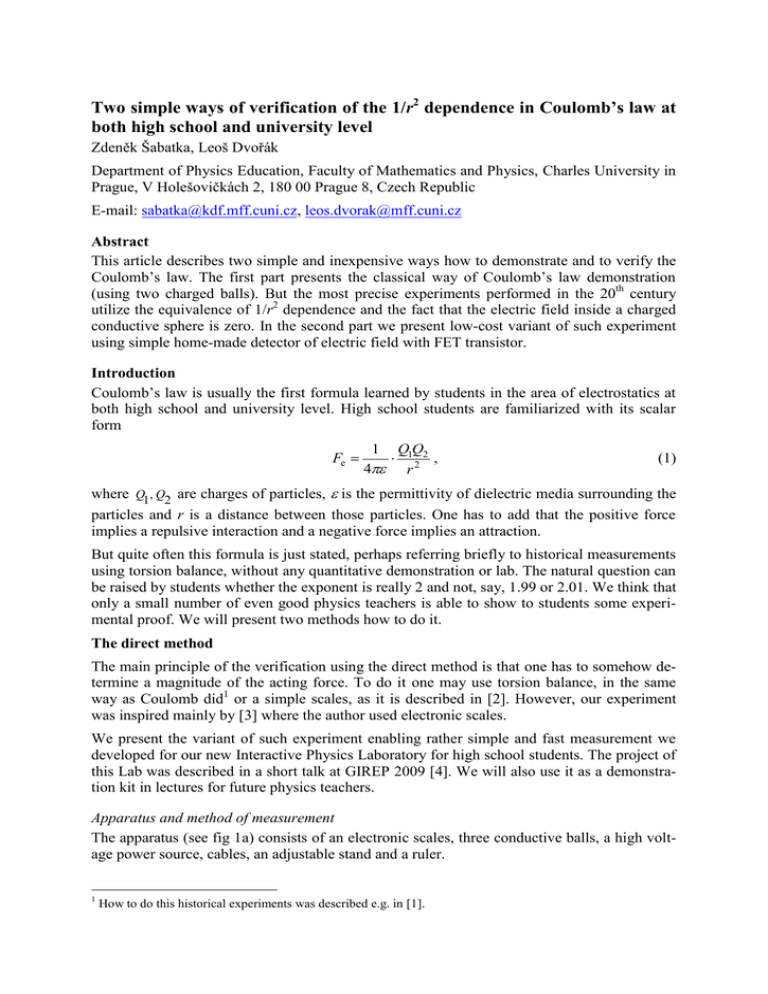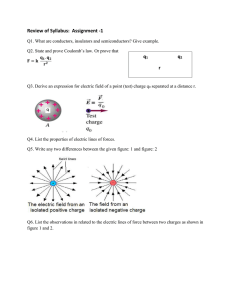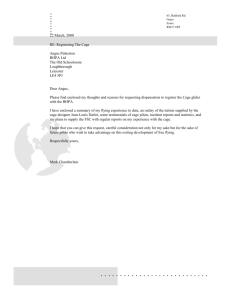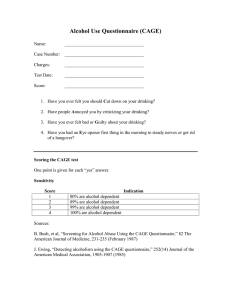Verify the dependence of electrostatic force on the distance at both
advertisement

Two simple ways of verification of the 1/r2 dependence in Coulomb’s law at both high school and university level Zdeněk Šabatka, Leoš Dvořák Department of Physics Education, Faculty of Mathematics and Physics, Charles University in Prague, V Holešovičkách 2, 180 00 Prague 8, Czech Republic E-mail: sabatka@kdf.mff.cuni.cz, leos.dvorak@mff.cuni.cz Abstract This article describes two simple and inexpensive ways how to demonstrate and to verify the Coulomb‟s law. The first part presents the classical way of Coulomb‟s law demonstration (using two charged balls). But the most precise experiments performed in the 20th century utilize the equivalence of 1/r2 dependence and the fact that the electric field inside a charged conductive sphere is zero. In the second part we present low-cost variant of such experiment using simple home-made detector of electric field with FET transistor. Introduction Coulomb‟s law is usually the first formula learned by students in the area of electrostatics at both high school and university level. High school students are familiarized with its scalar form Fe 1 Q1Q2 , 4 r 2 (1) where Q1, Q2 are charges of particles, is the permittivity of dielectric media surrounding the particles and r is a distance between those particles. One has to add that the positive force implies a repulsive interaction and a negative force implies an attraction. But quite often this formula is just stated, perhaps referring briefly to historical measurements using torsion balance, without any quantitative demonstration or lab. The natural question can be raised by students whether the exponent is really 2 and not, say, 1.99 or 2.01. We think that only a small number of even good physics teachers is able to show to students some experimental proof. We will present two methods how to do it. The direct method The main principle of the verification using the direct method is that one has to somehow determine a magnitude of the acting force. To do it one may use torsion balance, in the same way as Coulomb did1 or a simple scales, as it is described in [2]. However, our experiment was inspired mainly by [3] where the author used electronic scales. We present the variant of such experiment enabling rather simple and fast measurement we developed for our new Interactive Physics Laboratory for high school students. The project of this Lab was described in a short talk at GIREP 2009 [4]. We will also use it as a demonstration kit in lectures for future physics teachers. Apparatus and method of measurement The apparatus (see fig 1a) consists of an electronic scales, three conductive balls, a high voltage power source, cables, an adjustable stand and a ruler. 1 How to do this historical experiments was described e.g. in [1]. Figure 1 a) Apparatus for demonstration and verification of the Coulomb‟s law. b) “Weighting” the electric force. The conductive balls were made from ping-pong balls (approx. 4 cm in diameter) sprayed with copper-based conductive coating2, which is intended to shield from electromagnetic waves. One can also use other methods how to make the balls conductive, e.g. coat it using powder made out of a black lead. Each of those balls is fixed to a straw which makes together with a small plastic slab a stand of the ball. To verify the dependence Fe(r) one could charge both balls with the same charge and then while changing their relative distance observe the changing force acting between them. Balls could be charged by a high voltage power source (we used controlled power source up to 25kV). The electric force is detected using the electronic scales on which one of balls is placed (see fig 1b). The scales should have resolution at least 0,01g. Of course, more is better. But data bellow were really gathered using the scales with such resolution. Almost every scales has a function „tare‟ which allows you to “weigh” only the electric force between charged balls – the added weight matches the electric force. Students will get the force just by multiplying the number on the scales by the factor g3. Correction There is one problem which was not yet mentioned, and which could do troubles to students. Coulomb law is valid for pint charged particles (or homogenously charged spheres). But as everyone can see our balls are not point like. Moreover, especially when they are close to each other, the charge distribution would not be uniform on their surfaces. Therefore the force they repel would differ from the value given by the formula (1). So we have to use corrections to (1). The corrected formula looks a bit unfamiliarly: Fe 2 3 6 Q2 a a 1 4 14 . 4 0 r 2 r r (2) To be concrete we have used EMILAC. See [5] to get further information about it. g is standard gravity. In fact almost every scales with such resolution shows the weight in grams, so be aware of units. If you multiply the number on the scales by g you will get the force in milinewtons. 3 Here a is a radius of each charged sphere (in our case the ping-pong ball) and the rest is same as in a common version of Coulomb‟s law (1). The derivation of this formula can be found in [1]. 6 a In our case the term 14 and the following ones are so small that they could be neglected. r The final relation looks a bit simpler: Fe Q2 4 0 r 2 3 a 1 4 r (3) How to verify relation (3) using e.g. MS Excel? (Note that Excel is able to fit only built in functions.) So, one has to transform the equation (3) to Fe Fe 3 a 1 4 r Q2 , 4 0 r 2 (4) where Fe is now a “corrected force” with correction – the force which would be measured if the charges would be point like. Results An example of one measurement is shown in the graph 1. To show how important it is to do the correction we have added also the dependence without the correction mentioned above. Graph 1 Comparison of the really measured force F'e (•) and the force with correction Fe (). Looking at the graph and also other experimentally determined exponents (-2.026, -1.937, -2.071, -2.001) we may say that we have proved the dependence 1/r2 in Coulomb‟s law. There is of course some inaccuracy of our measurement. Because we measure at maximum about 0.20g with sensitivity 0.01g, we can estimate the overall uncertainty to be of the order of (0.01/0.20)∙100% = 5%. Cavendish type experiment Yet, student measurements using charged spheres cannot aspire to high precision and should be considered rather as rough estimates of the exponent in Coulomb‟s law. The most precise experiments performed in the 20th century utilize the equivalence of 1/r2 dependence and the fact that the electric field inside a charged conductive sphere is zero. The quantitative analysis of such measurement fits to introductory university course (e.g. for future physics teachers), the simplified reasoning can be presented also at high school level. Idea As mentioned above our new goal is to proof that inside a charged Faraday‟s cage there is no electric field. That‟s the fact which directly results from the Coulomb‟s law. Let‟s assume that the electric force does not vary as 1/r2, but as 1/r2+ε. Then we are able to calculate that in a spherically symmetric case the difference between electric potentials on the surface (ϕin) of the cage and inside (ϕ0) is about in 0 0.2 0 (5) Figure 2 Potentials inside and on the Faraday‟s cage. (The derivation of (5) is, in fact, not harder than some end of chapter textbook tasks; we will present it elsewhere.) The indicator To measure the difference of potentials we need some meter or indicator. We have built one (see fig 3) using a FET (field-effect transistor). To indicate that there is some potential between contacts A and B we use a green light emitting diode – the brightness of the diode indicates the voltage between A and B. When A and B are connected we set the brightness of the LED to some intermediate level using the potentiometer. The non-zero voltage between A and B is indicated by change of the brightness of the LED. We proved during testing that the sensitivity of our indicator is better than 50mV. 56K 390 A BS170 25 K 9V 10K B Figure 3 Home-made indicator of electric field with FET. a) Circuit diagram b) The real indicator Experimental setup We have placed the indicator including its power source (9V battery) inside a Faraday‟s cage and attached one of contacts to the cage and other one to a can placed also inside the cage on a piece of Styrofoam (see fig 4). Figure 4 Experimental setup Results and accuracy We started our experiments with a Faraday‟s cage with many holes (see figure 4). We found out that our indicator in such cage reacts also to a charged rod outside the cage. Evidently the field could “enter” into such not so perfect Faraday‟s cage. So we decided to cover the cage step by step. For covering we used aluminium foil. We connected the cage to the high voltage source (25kV) and watched the indicator‟s LED inside the cage. For “partly opened cage” the LED still changed its brightness, so we made the hole smaller and smaller. Finally we were successful and made the cage (see fig 5) inside which was the electric field smaller then the indicator was able to detect (the potential difference was certainly smaller then 50mV). Figure 5 The Faraday‟s cage in which no electric field was4. a) The cage connected to high voltage source b) A small hole in the cage through which we observed the indicator. So we have proved that there is no electric field in a good Faraday‟s cage. Therefore we can conclude that the dependence of electrostatic force between point charges is really 1/r2. 4 There is probably some electric field, but it is below the sensitivity of our indicator. What is the accuracy of our statement? We have assumed that the dependence of force on distance is 1/r2+ε. In this case the difference of electric potential would be approximately in 0 0.2 0 . In our experiment the difference in 0 50 mV . The potential of the outer part of the cage was 0 25 kV . We are able to estimate the value of ε as 5 0 in 50 103 5 105 . 3 0 25 10 (6) So the inaccuracy of our statement that in Coulomb‟s law is the dependence 1/r2 is less than 10-5. Looking at table 1 one could find out that accuracy of our experiment is five times better than that obtained by J.C. Maxwell‟s and much better than that of Cavendish‟s experiment. Of course, the 20th century experiments are orders of magnitude more precise than our experiment described above – but they are not small enough and cheap enough to be used in schools. Experimenters Year Accuracy H. Cavendish 1772 0.02 J. C. Maxwell ~1872 Plimpton and Lawton 1936 5 105 2 1010 Williams, Faller, Hill 1971 2.7 3.11016 Table 1 The accuracy of historical experiments confirming the dependence 1/r2 in the Coulomb‟s law [6] Conclusions The main point of our contribution was to show that even at high school it is not so big problem to do experiments proving fundamental laws of physics, e.g. Coulomb‟s law. Of course we were focused only on one concrete part of Coulomb‟s law. But one can also show the dependence of electric force on charge or on its surroundings (permittivity). Experiments presented in this article will be used as demonstration experiments at the lecture on Classical Electrodynamics for future physics teachers and also in our Interactive Physics Laboratory for high school students. The work described in this article was supported by grant FRVŠ 1237/2010/G6 of Czech Ministry of Education, Youth and Sports. References [1] Martínez, Alberto A. 2006 Replication of Coulomb's Torsion Balance Experiment Archive for History of Exact Sciences 60 517-563 [2] Larson C O and Goss E W 1970 A Coulomb„s Law Balance Suitable for Physics Majors and Nonscience Students Am. J. Phys. 38 1349-1352 [3] Cortel A 1999 Demonstrations of Coulomb„s Law with an Electronic Balance Phys. Teach. 37 447-448 [4] Zdeněk Šabatka, Zdeněk Drozd and Leoš Dvořák, Activities for high school students: from demonstration experiments to an interactive laboratory, GIREP-EPEC, Oral Sessions – Experiments, Leicester, 2009 [5] Produktdetails – Lacquers – EMILAC [cit. 2010-10-13] <http://itwcp.de/contentcenter/content.php?action=details&rubrikid=496&ID=383&template=detail_tpl _produkte_en.html> [6] Jackson J D 1998 Classical Electrodynamics ISBN 978-0471309321


